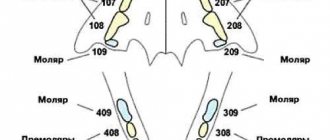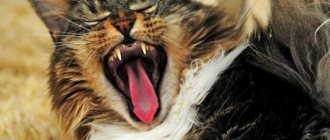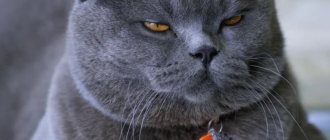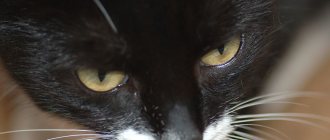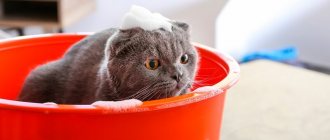Formation of primary dental occlusion
Almost all mammals are born toothless. Cats are no exception: the oral apparatus of a newborn kitten is maximally adapted for effective sucking. After all, the only food available to him is mother’s milk.
At two weeks of age, kittens develop milk teeth - straight, small, sharp, milky white. In adult cats they are powerful and curved. They are called milk teeth because they appear in kittens during breastfeeding.
Interesting! The front milk teeth of kittens are straight, and the fangs are curved.
Teething order
The eruption period lasts up to two months. By this age, the cat already has 26 baby teeth. They do not appear all at once, but in a certain order:
- 2–4 weeks. Incisors appear. First, 2 in the center of the jaw, then 4 more are added to them on both sides. There are 12 incisors in total - 6 each on top and bottom.
- 3–4 weeks. Fangs appear: 4 upper and 4 lower. They are located on the sides of the incisors.
- 4–8 weeks. The appearance of pre-masticating teeth - premolars: 4 on the lower jaw and 6 on the upper jaw.
Important! Milk teeth will serve kittens up to the age of 3-4 months with proper care and timely introduction of complementary foods.
Contraindications to tooth extraction at home
Before choosing a method to extract a tooth yourself, it is important to make sure that this manipulation will not cause harm. The presence of the following manifestations is a contraindication for removing thrush at home:
- redness of the gums;
- strong adhesion of the tooth to the jaw;
- thickening of the gums due to swelling;
- the presence of blood or pain when the milkman staggers;
- increased body temperature, signs of acute respiratory viral infection, sore throat;
- the child has severe fear.
When performing a manipulation, you cannot hold the child by force, otherwise the fear of performing procedures in the mouth will remain for life. In all doubtful and complex cases, you should contact a specialized specialist - a pediatric dentist.
Children often experience carious lesions in primary teeth, leading to their partial destruction. Such situations require a mandatory visit to a doctor with subsequent treatment or removal. Even severely damaged carious teeth cannot be pulled out on your own - this will lead to pain and injury to the gums and lips.
Changing baby teeth to permanent ones
The replacement of baby teeth with permanent teeth in cats begins at 4 months. The formation of the masticatory apparatus is completed at 7–8 months. The time it takes for a permanent bite to develop may vary among different cat breeds. A slight advance or delay in deadlines is allowed.
Shift order
The location and order of changing baby teeth to permanent ones is clearly depicted in the figure below. The first to fall out are the deciduous incisors. Fangs change after complete replacement of incisors. Next comes the replacement of the premolars. After a complete change, 4 molars erupt - the main chewing ones. In the picture they are colored blue.
Types of permanent teeth
An adult cat should have a total of 30 teeth. For a cat, it is a weapon, a means of protection, defense and attack. Mother cats use their front incisors to gently grab and carry the kitten.
Interesting! In cats, the lower jaw can only move in a vertical plane, so it is incorrect to say that cats chew their food. They crush it, crush it into small pieces.
The table describes the location of cat teeth, their number and functional load.
| Upper jaw | Incisors – 6 | They serve to hold prey and tear off small pieces of food. | Fangs – 2 | Used for self-defense, capturing and chopping food | Premolars – 6 Molars – 2 | They grind the bones and crush large pieces. |
| Lower jaw | Incisors – 6 | Fangs – 2 | Premolars – 4 Molars – 2 |
Molars are located deep in the jaw. Their presence indicates that the cat has become an adult. During this period, he begins to mark his territory.
Causes of tooth loss in adult cats
Causes of loss of fangs with incisors in an adult cat:
- injuries or infectious diseases in the oral cavity;
- weakened immune system;
- lack of vitamins;
- diabetes;
- tartar;
- metabolic problems;
- pregnancy;
- therapy with hormonal veterinary drugs (antibiotics or contraceptives);
- incorrectly formed bite;
- stomatitis, periodontal disease, gingivitis, or other dental diseases;
- serious stomach or intestinal problems;
- oncology.
There is an opinion that cats lose teeth due to age and their loss in pets over 8 years old is a natural phenomenon. This version is wrong.
Cats lose their incisors and canines from old age when they reach the age of 20, but rarely does any individual live to such years.
How to help a cat
If a cat's teeth are falling out, owners should monitor the cat for changes in behavior and additional pathological symptoms. Any signs noted must be reported to your veterinarian. This data will be required for the correct diagnosis and subsequent prescription of effective treatment for the furry patient.
Depending on the cause of the loss of incisors and fangs, the doctor will be able to offer the following methods of solving the problem:
- Prescribing a special diet.
- Prescription of immunostimulants.
- Treatment of gum diseases.
- Removal of tartar under “premedication” or general anesthesia.
- Treatment of the underlying disease.
Symptoms of teething or changing teeth
By the behavior of kittens and the reaction of a nursing cat, you can understand that they are cutting their first teeth. The appearance of primary incisors is accompanied by swelling and soreness of the gums. The kitten is trying to get rid of unpleasant sensations, so during feeding it clenches its jaws with force and bites its mother's nipple.
Sharp incisors can injure the nurse. But this period does not last long and often goes unnoticed by the owners.
By the end of the 4th month, the rudiment of a permanent tooth is formed in the gums of the upper and lower jaws under each milk tooth. As it grows, baby teeth shift, are pushed out of the gums and fall out one by one. This occurs at approximately 5 months.
Replacing baby teeth with permanent ones causes noticeable changes in the kitten's behavior. During this time, your pet's condition should be monitored to help if complications arise.
Symptoms of teeth changing in kittens:
- When young cats lose their baby teeth, they become biters in an attempt to get rid of itchy gums. You should not allow the kitten to bite the owner's hands. It will be very difficult to re-educate him later.
- Excessive salivation appears - ptyalism. This is how nature protects delicate gums from possible inflammation.
- An unpleasant odor appears from the mouth. The reason is moderate inflammation.
- Possible increased body temperature, lethargy or agitation, aggression. This is a reason to contact a veterinarian.
- Kittens lose their appetite or refuse solid food because their swollen, inflamed gums are painful to chew. Dry food should be removed from the diet, leaving only soft food.
Important! When kittens change teeth, it is necessary to exclude the animal from access to anything that could harm it. For example, when chewing wooden surfaces, a cat can hurt its gums.
To make the teething process go smoothly, you can purchase special “chewing” toys.
Lost primary incisors can be discovered by the owner during play. But most often kittens swallow them while eating. This is normal - everything will work out naturally.
Oral hygiene for a kitten
During the change of teeth, oral hygiene in a kitten becomes important. It is necessary to teach a kitten to oral hygiene from a very early age, so as not to suffer in the future with an adult cat.
They usually start with a game - when the kitten begins to get used to a special toothbrush for animals and stops being afraid of it. The kitten will be happy to grab the bristly brush, especially when his gums itch. The main thing is to do this constantly, then the cat will get used to this hygiene procedure.
This will allow you to avoid problems such as tartar (tartar in cats) and the development of periodontitis in the future.
Possible complications
The eruption of baby teeth and their replacement with permanent teeth are natural processes of growth for any animal. They must take place on time. It is necessary to contact a veterinarian in time if complications arise:
- The kitten has been sleeping poorly for the last 24 hours, not eating, restless, and meowing.
- The unpleasant odor does not go away for a long time, it becomes pungent - periodontal disease may develop.
- Excessive secretion of saliva and its thickening - the likelihood of gingivitis or stomatitis.
In order not to miss alarming symptoms when cats change teeth, you need to regularly examine the oral cavity.
Gum inflammation
A healthy cat's gums should be pale pink and free of swelling. During eruption, swelling, redness, slight swelling and short-term bleeding are allowed. These phenomena quickly pass: the swelling quickly subsides, the hole in the place of the lost tooth heals without a trace.
You should not postpone a visit to the veterinarian if:
- inflammation has occurred around the baby tooth;
- Reddened gums bleed for a long time;
- pus appears on the gums or in the sockets;
- the baby incisor is “slanted” and injures the gums, this usually happens with fangs.
All of these signs are symptoms of periodontal disease, stomatitis, and gingivitis. Purulent inflammations are especially dangerous.
Interesting! Scottish Fold cats are the most prone to gum disease. The owners of Scottish dogs should be especially attentive to them during this difficult period.
Residual baby teeth
Usually the new tooth grows in its own socket. Therefore, it often happens that a permanent one grows next to a milky one that has not yet fallen out. This is the norm, but if a baby tooth does not fall out in 8 months, this is a reason to consult a doctor.
An anomaly, when permanent teeth have already erupted, but milk teeth have not yet fallen out, is rare. In this case, a double dentition is formed and, as a result, an incorrect bite. In this case, the oral mucosa, the inside of the cheeks, and the kitten’s tongue are injured.
If more than one or two primary incisors remain in the pet's jaw, surgical intervention and strict monitoring of the subsequent eruption process are inevitable.
Expert opinion
Chepa Natalya Semenovna
Veterinarian
Ask an expert
In some cases, kittens may develop juvenile gingivostomatitis after teething. This is an inflammation of the gums that develops after the appearance of permanent teeth. Young cats under 2 years of age are affected. The exact causes of the inflammatory process have not been fully established. The disease probably occurs against the background of an allergic reaction of the body to plaque bacteria. Some breeds have a predisposition: Maine Coons, Sphynxes, Bengals, Orientals. Characteristic signs of juvenile gingivostomatitis are bad breath, redness and swelling of the gums. To treat the disease, sanitation of the oral cavity with antiseptics, for example, Miraxidin solution, is prescribed. In difficult cases, ultrasonic teeth cleaning may be required. To prevent the disease, it is recommended to brush your pet’s teeth with special pastes for animals. Moreover, it is better to accustom your cat to the procedure from childhood.
What should the owner do?
The pet owner must strictly follow the veterinarian's recommendations. Self-medication is unacceptable. In such a situation, the animal may suffer irreparable harm.
The selection of medications and determination of their dosage should be carried out exclusively by a specialist.
The doctor will also tell you about the cat’s nutrition during the treatment period. It is recommended to change the consistency of the food: dry granules injure already inflamed mucous membranes. It is recommended to give preference to soft food.
It is necessary to systematically examine the oral cavity and treat it with a Chlorhexidine solution. In this way, it will be possible to avoid destruction and infection of the enamel and damage to other teeth.
